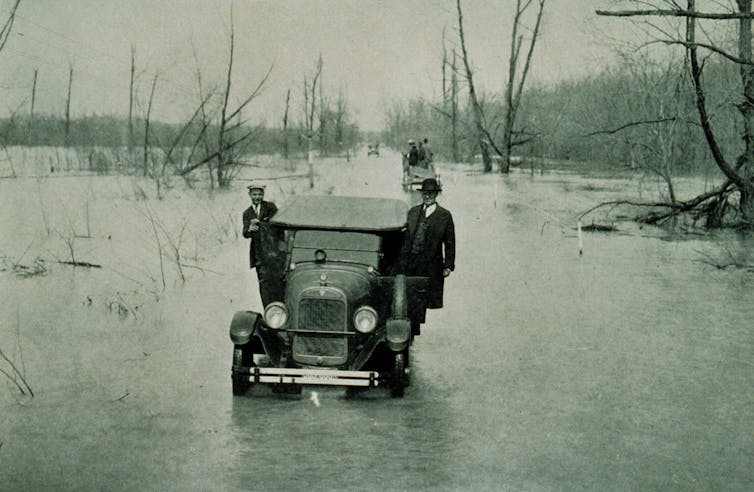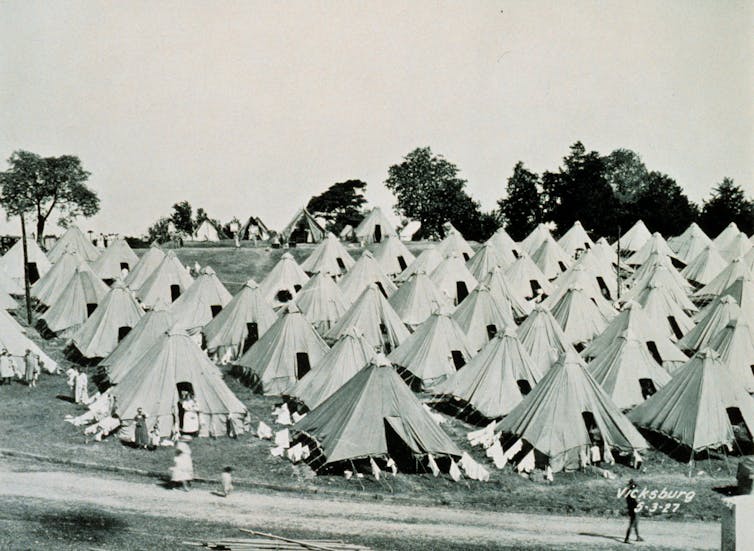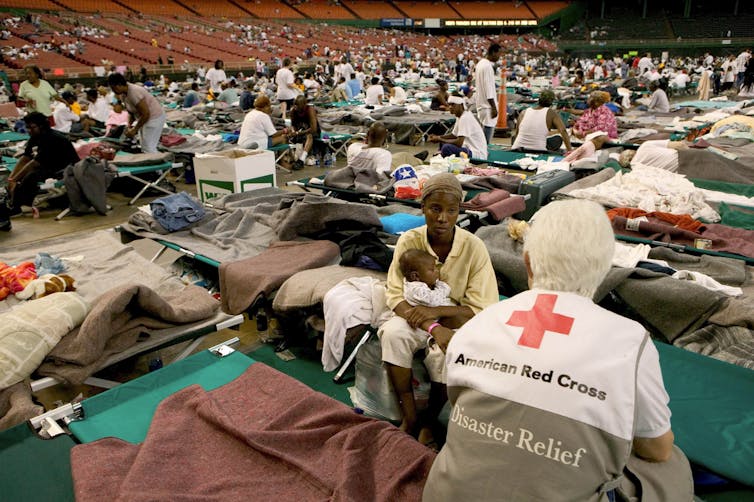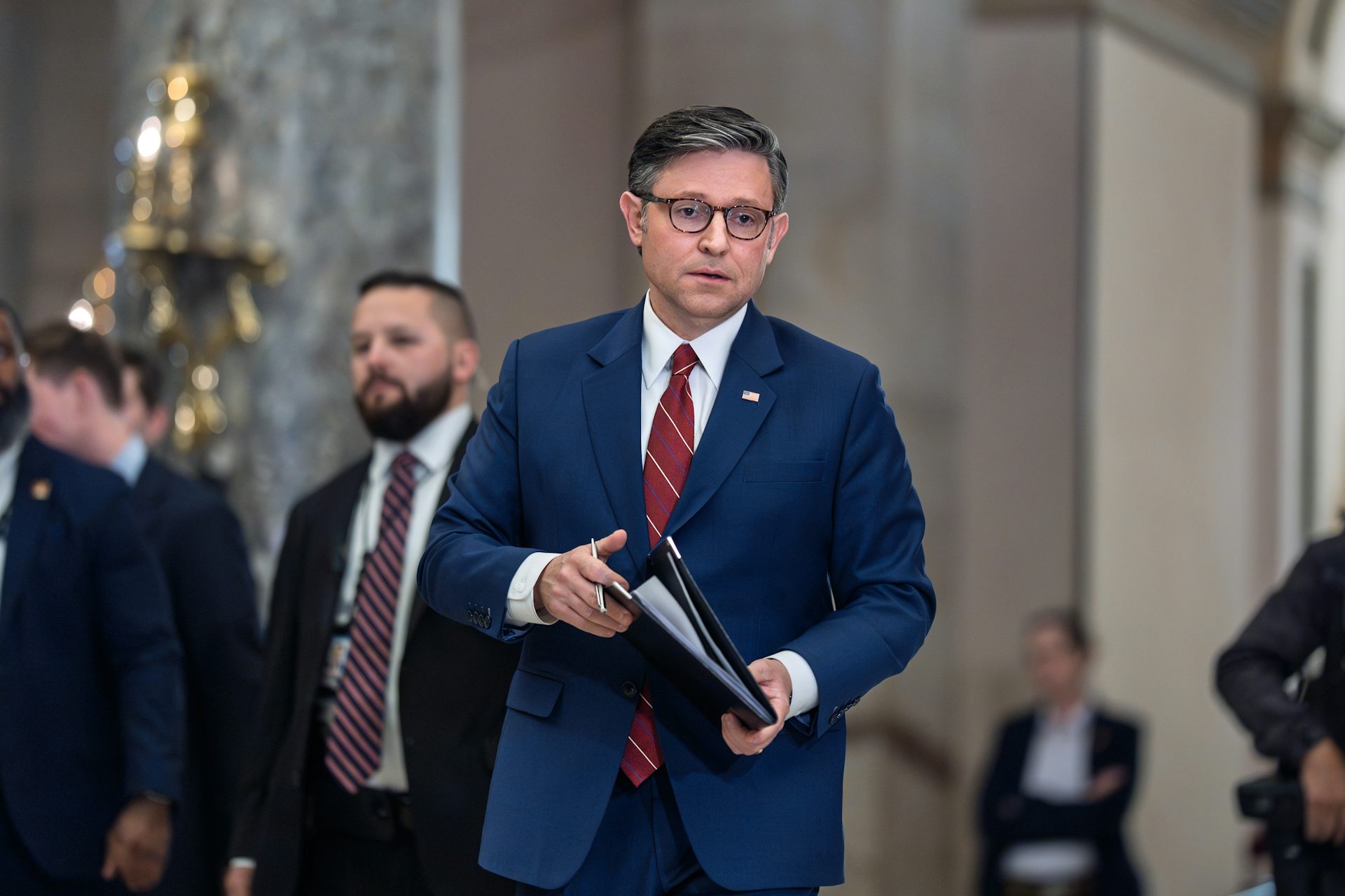History shows why FEMA is essential in disasters, and how losing independent agency status hurt its
States used to be on their own when a disaster hit. Then the Great Mississippi River Flood of 1927 and the Dust Bowl showed why federal coordination was essential.

When the head of the Federal Emergency Management Agency’s urban search and rescue team resigned after the deadly July 4, 2025, Texas floods, he told colleagues he was frustrated with bureaucratic hurdles that had delayed the team’s response to the disaster, acccording to media reports. The move highlighted an ongoing challenge at FEMA.
Ever since the agency lost its independent status and became part of the Department of Homeland Security in the early 2000s, it has faced complaints about delays caused by layers of bureaucracy and red tape, leaders at the top with little experience in emergency response, and whiplash policy changes.
Now, the Trump administration is cutting jobs at FEMA and talking about dismantling the agency, which would push more responsibility for disaster response to the states.
Yet, federal emergency management is crucial in America.
I run the Hazards Vulnerability & Resilience Institute at the University of South Carolina and for years have worked with states and communities facing hazards and disasters. To better understand FEMA’s value, let’s take a look back at how the nation responded to disasters before the agency existed, and what history reveals about when FEMA was most effective.
Disaster response without the US government
Before 1950, disaster relief and response were not considered a federal responsibility. When a hurricane, flood or tornado hit, community members and humanitarian groups, such as the American Red Cross or Salvation Army, brought in food, shelter and medical aid and solicited charitable donations to help people rebuild.
State and local governments had primary responsibility for disaster response. But mostly people relied on family, neighbors and charity.

Federal aid was approved on a case-by-case basis. War Department guidelines in 1917 stated that aid would be allowed only if a senior military officer certified that responding to the disaster would exceed local and state resources.
Then the Great Mississippi Flood of 1927 and the 1930s Dust Bowl gave new meaning to the concept of disaster in America.
In 1927, the Mississippi River broke through its levees, submerging more than 1 million acres of land across seven states. An estimated 700,000 people were displaced from their homes and workplaces.

Herbert Hoover, then U.S. commerce secretary, was given full authority to create, coordinate and carry out the federal relief effort. The Red Cross set up camps using tents provided by the War Department. Coast Guard and Navy boats rescued people stranded by flooding. But the response drew criticism for the lack of direct federal money to help flood survivors and the treatment of Black sharecroppers and laborers.
A few years later, the droughts of the Dust Bowl era began destroying crops in the Great Plains, causing widespread damage.
Federal disaster aid begins to take shape
After the flood, the federal government began to formalize its role in disaster management.
Flood control projects became a federal responsibility with the passage of the Flood Control Act of 1928. President Franklin D. Roosevelt’s New Deal provided emergency relief to farmers in the Great Plains and set up the Soil Conservation Service to help them reduce the effects of future droughts. These were among the first disaster mitigation policies at the federal level.

There was little coordination among agencies, however. Various aspects of disaster relief and recovery were handled by the departments of Defense, Agriculture, and Housing and Urban Development and the Small Business Administration. Each had its own rules and requirements.
In 1950, Congress passed the Federal Disaster Relief Act, establishing the first permanent authority for federal disaster relief.
The act gave the president the responsibility to determine how aid would be distributed and which agencies would be involved. The legislation also broadened the federal mission to include disaster preparedness and mitigation and formalized the process for issuing presidential disaster declarations.
The creation of FEMA
By the 1970s, large-scale disasters such as hurricanes Betsy (1965) and Camille (1969), and the fragmented disaster response, led the National Governors Association to call for a single comprehensive emergency management agency. Its report provided the blueprint for President Jimmy Carter’s 1979 executive order that established the Federal Emergency Management Agency, or FEMA.
The new agency became the home for emergency management within the executive branch. It was intentionally designed as an independent federal administrative agency that could work across federal agencies to support state and local governments in times of crisis.

FEMA wasn’t created to lead the disaster response. Instead it helps state and local officials by mobilizing federal resources, such as search and rescue, debris removal and funding when a disaster overwhelms the state’s capacity. FEMA could do this quickly because of established federal contracts and its ability to move equipment and responders into the region before a disaster hits.
When things began to fall apart
However, FEMA’s ability to act fast changed after the Sept. 11, 2001, terrorist attacks. The agency was restructured as a unit in the newly formed Department of Homeland Security. But the Department of Homeland Security’s focus was on terrorism and law enforcement, not natural disasters.
The loss of autonomy and direct reporting to Congress, unfunded mandates outside the scope of the 1988 Stafford Disaster Relief and Emergency Assistance Act, and major increases in the number of large and complex disasters stretched FEMA’s capabilities.
When Hurricane Katrina hit New Orleans in 2005, FEMA’s response drew widespread criticism. It was slow to deploy people and supplies and lacked enough experienced responders who knew what to do. Decision-makers were not familiar with new national response plans. Further breakdowns in communications and a lack of coordination among agencies led Congress to declare the Hurricane Katrina response a failure of initiative and agility.

FEMA’s reputation improved after the government brought in more experienced leadership and committed to preparedness planning and better response capabilities.
However, the first Trump administration, from 2017 to 2021, reversed those gains. Three different heads of FEMA in four years led to understaffing and conflicting directions.
As Trump took office for the second time in 2025, he and his administration talked about dismantling FEMA and pushing more disaster management to states. Job cuts and resignations at FEMA reduced the number of employees with training and experience vital in disasters. Political appointees to senior roles in the agency and in the Department of Homeland Security lacked emergency management training and experience.
A new policy that all purchases over US$100,000 be personally approved by Homeland Secretary Kristi Noem led to more resignations. For disaster response, a delay in waiting for a signature to work its way up the chain can cost lives.
What now?
Dismantling FEMA and leaving little or no federal coordination of disaster response puts states in a difficult position.
States must balance their budgets every year, and increasingly “rainy day” funds are insufficient to cover unexpected large disasters. As the federal government shifts other financial responsibilities to states, funds will diminish further.
A single disaster can cause hundreds of millions of dollars in damage and require widespread disaster response and then relief efforts. Since 1980, the cumulative cost of weather-related disasters has exceeded $2.9 trillion. With a warming atmosphere producing more intense storms, increasing human and economic harm are likely.
Members of Congress have proposed making FEMA an independent, Cabinet-level agency again. I see some distinct advantages in doing so:
Fewer management layers would enable faster deployment of federal supplies and personnel to assist disaster response.
A streamlined, more nimble agency could cut red tape for disaster survivors needing assistance, meaning delivering relief funding faster and more equitably.
If an independent FEMA had responsibility for recovery beyond its current 180-day reimbursement limits, that could improve long-term recovery efforts, especially if Congress provided permanent funding streams and consistent rules and regulations.
The Trump administration’s efforts to dismantle FEMA are shortsighted in my view. Instead, I believe the best move is to restore FEMA as an independent executive agency as it was originally envisioned.
Susan L. Cutter receives funding from the U.S. National Science Foundation.
Read These Next
Midlife weight gain can start long before menopause – but you can take steps early on to help your b
What you do in the years leading up to menopause can help counter the natural hormonal effects of aging,…
Who thinks Republicans will suffer in the 2026 midterms? Republican members of Congress
The president’s party almost always loses seats in the midterms. More than two dozen Republican House…
Resolve to network at your employer’s next ‘offsite’ – research shows these retreats actually help f
Because they can help you get to know more of your co-workers, offsites may build the kind of trust…






